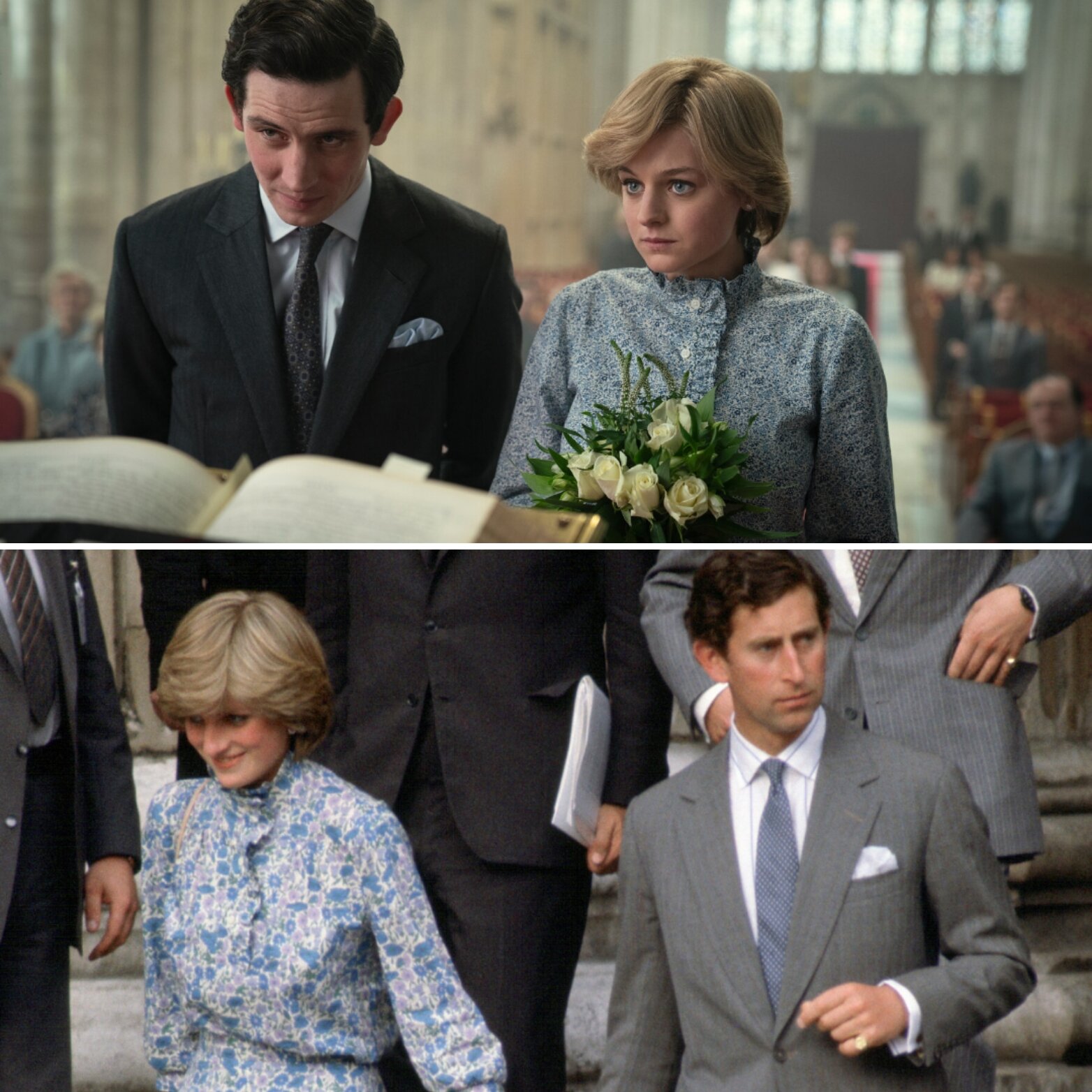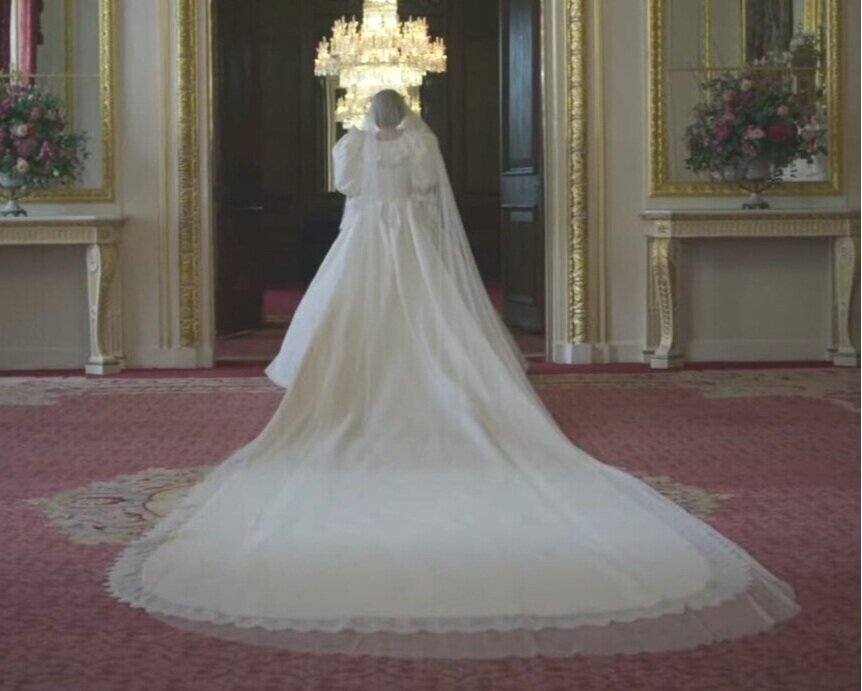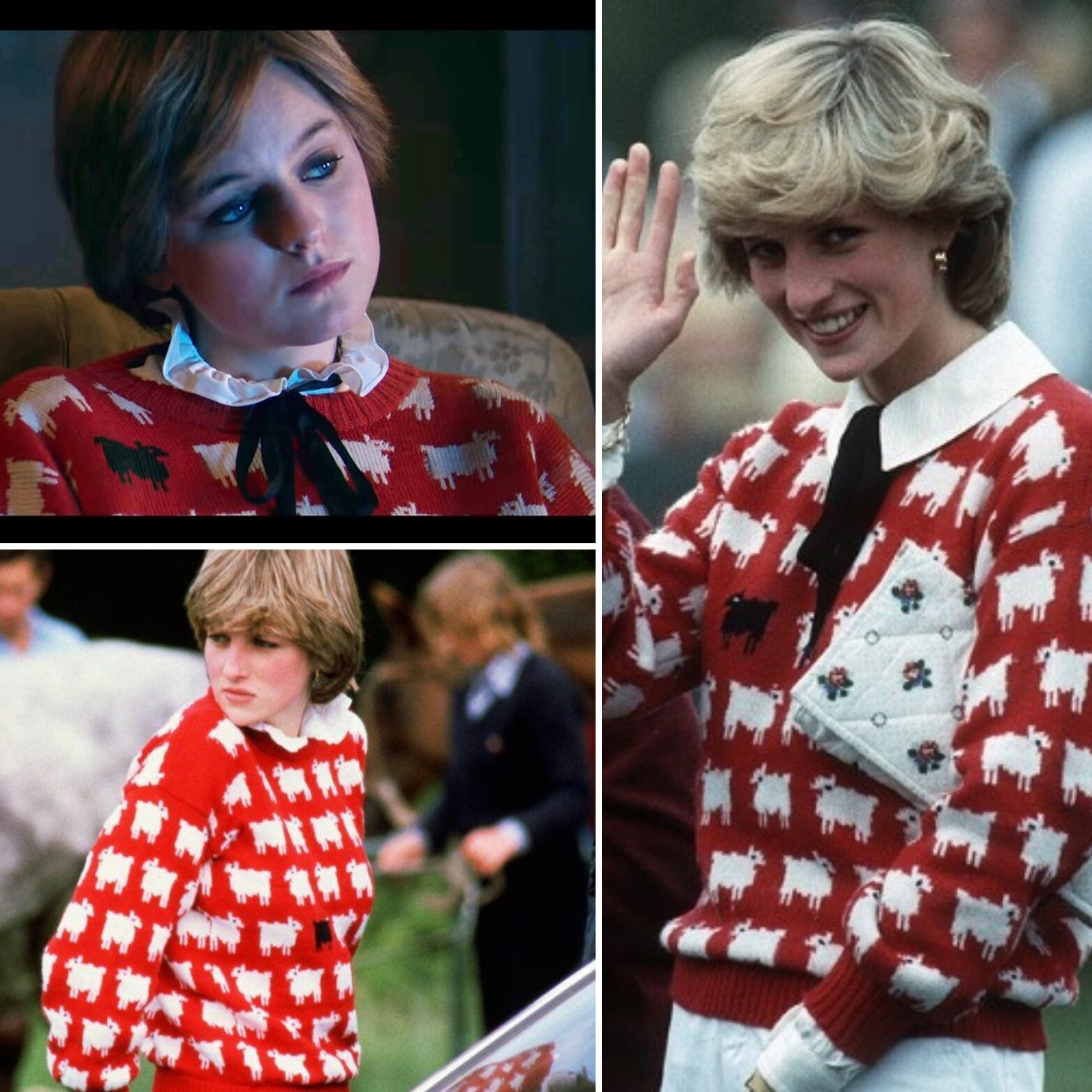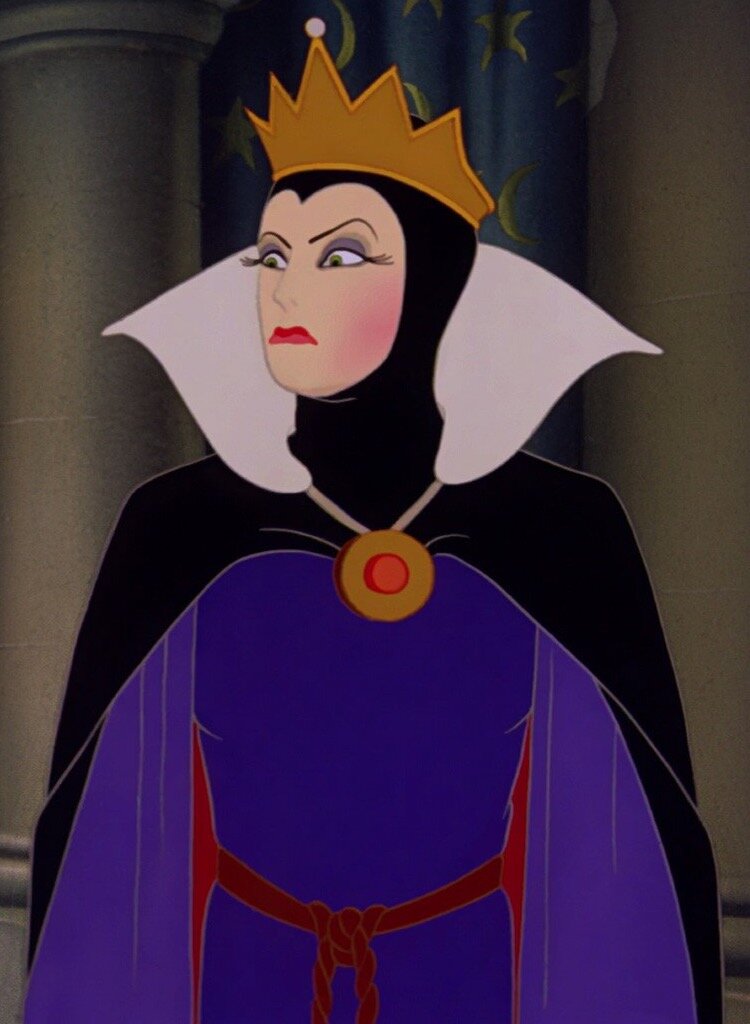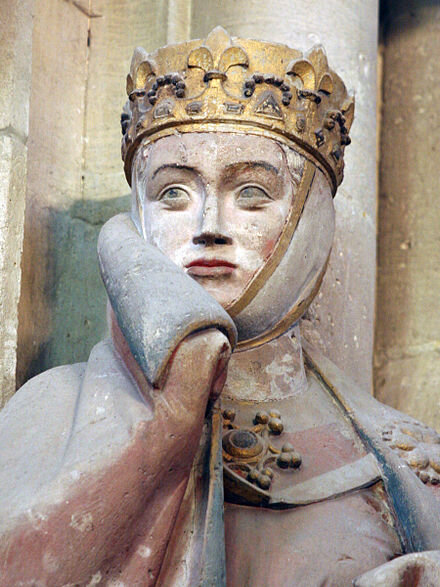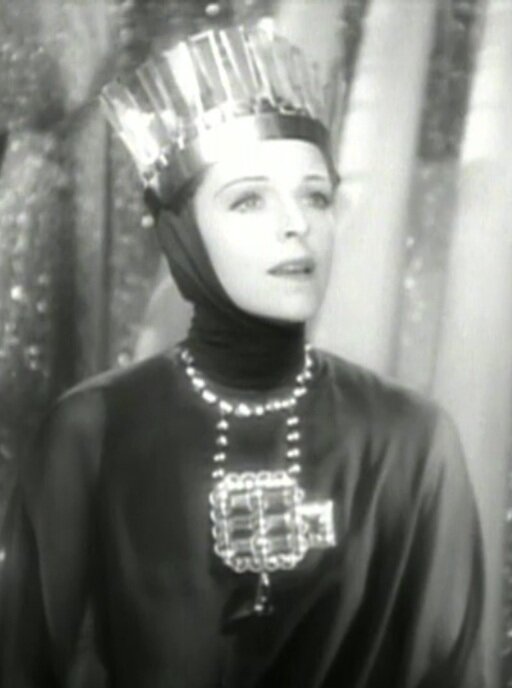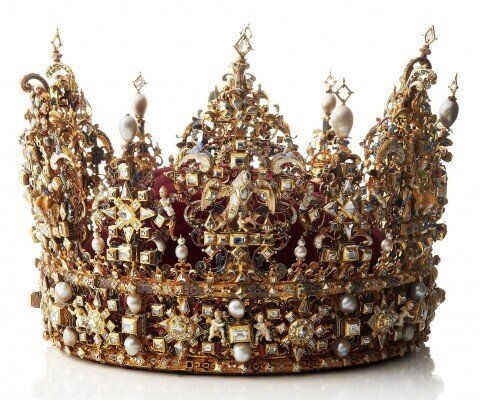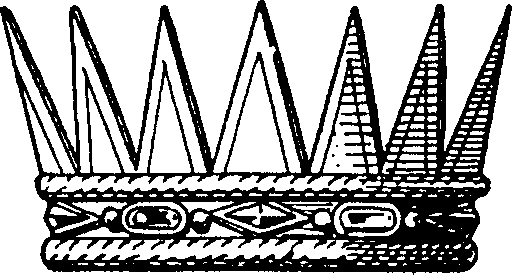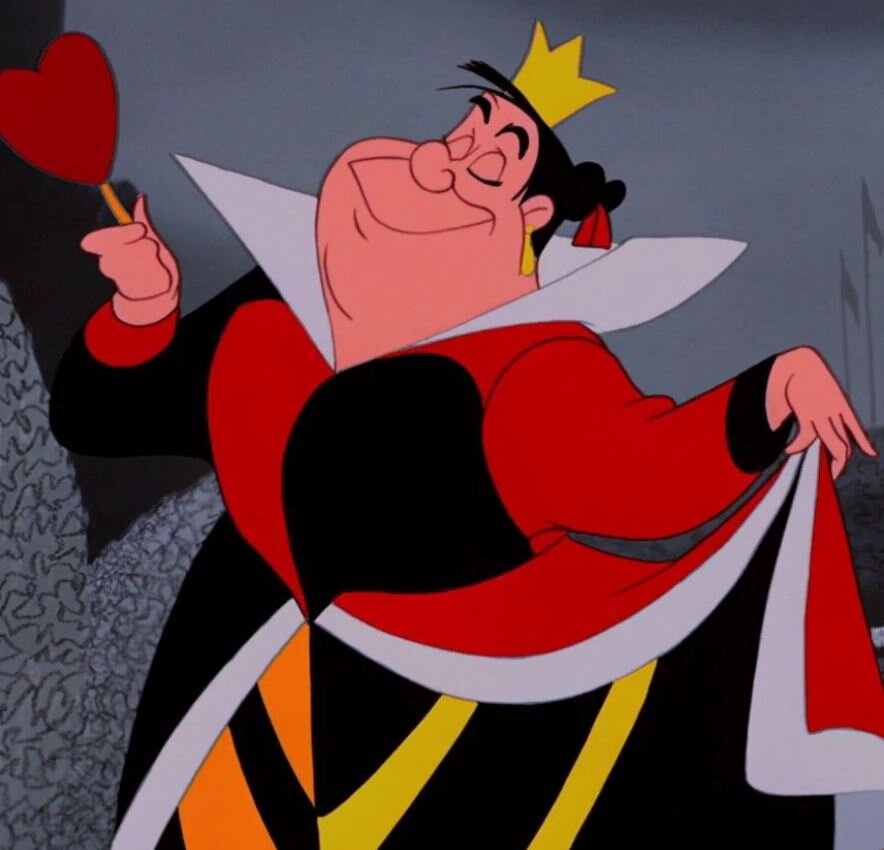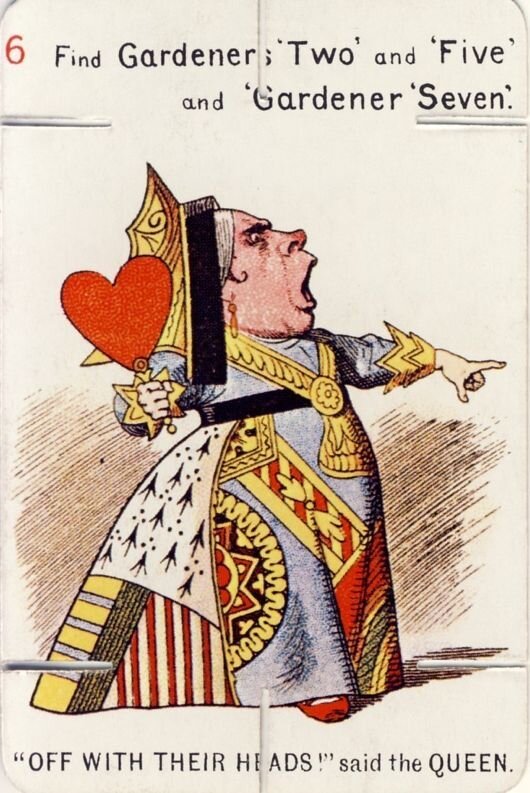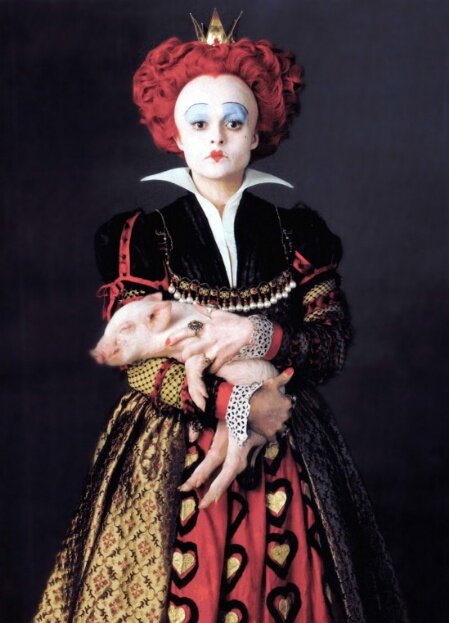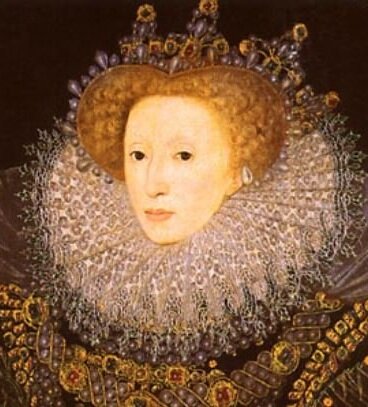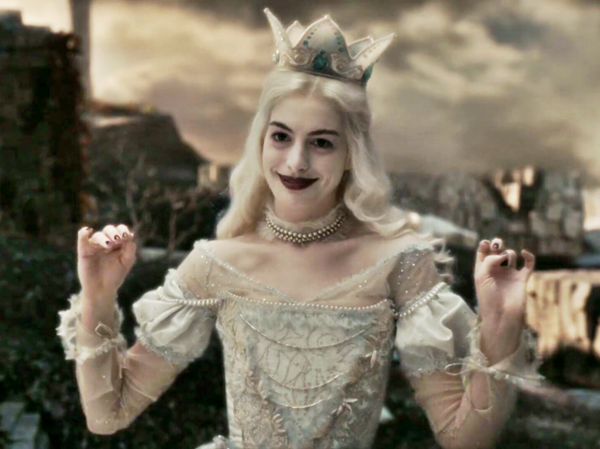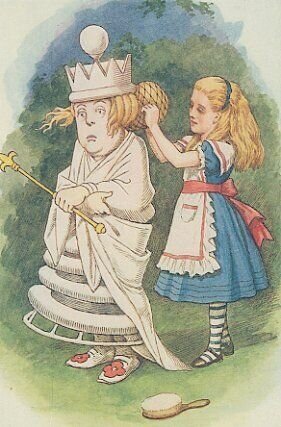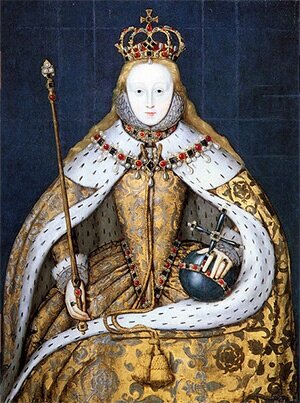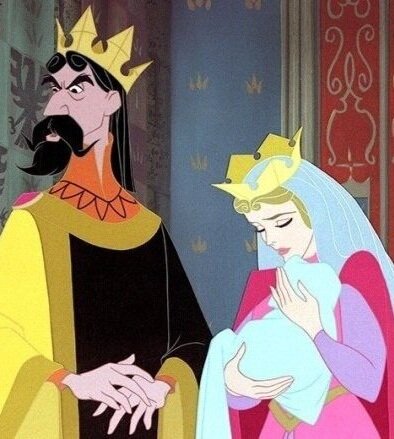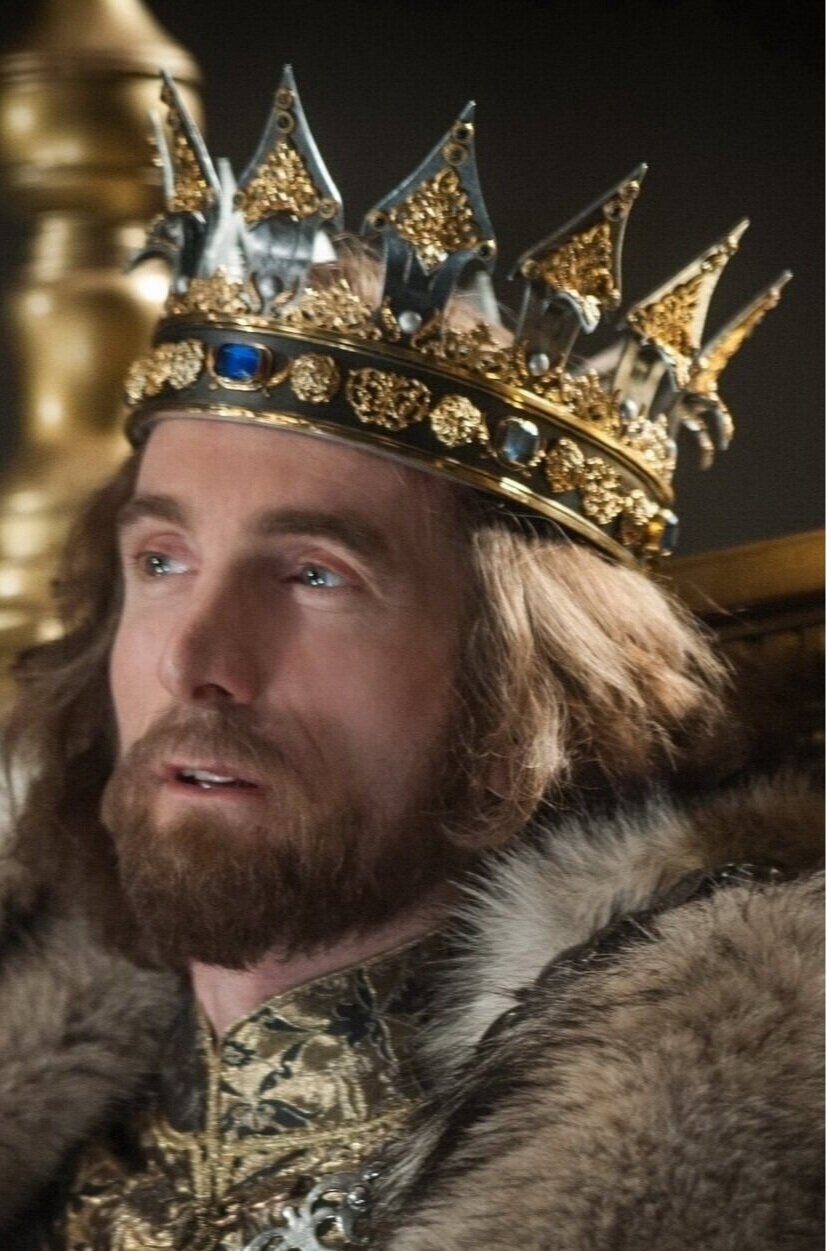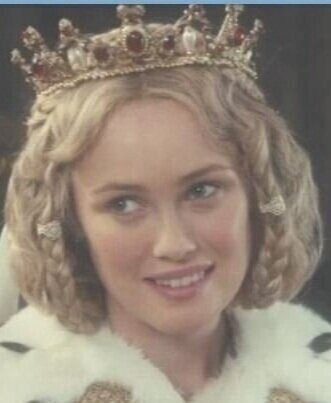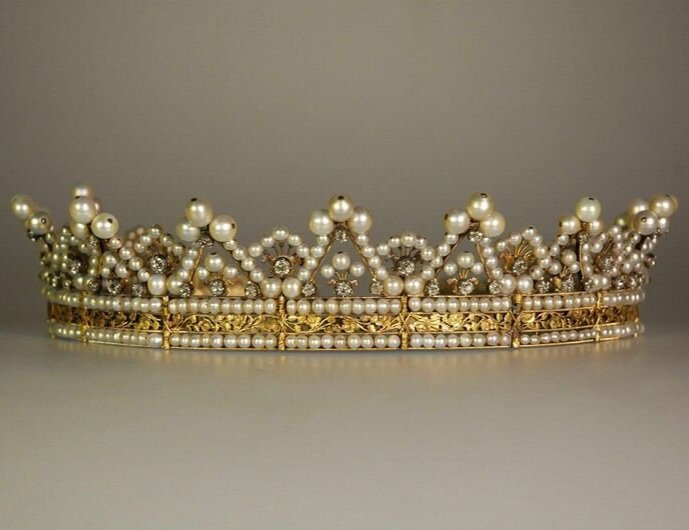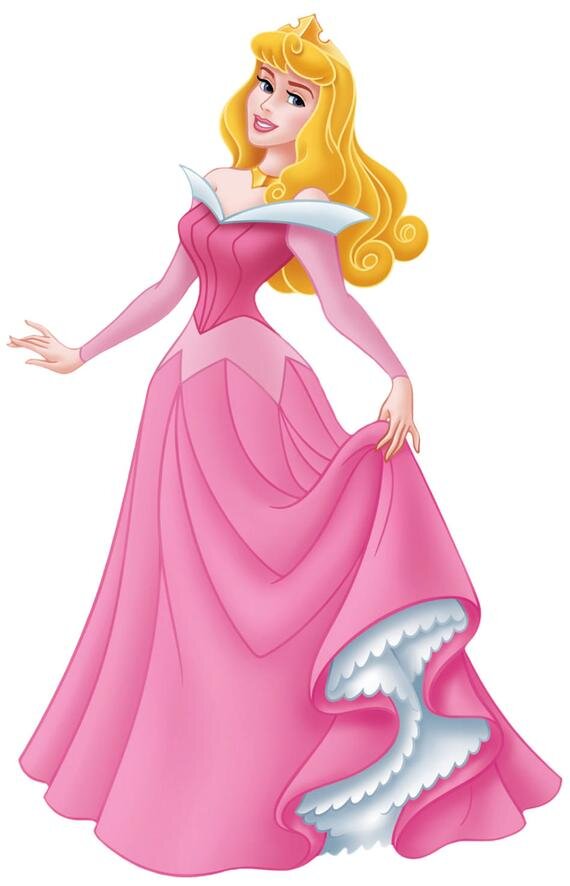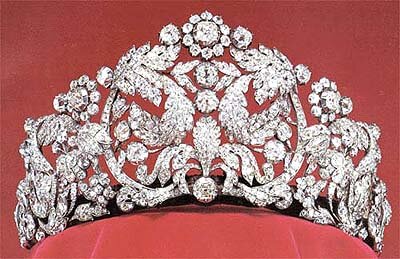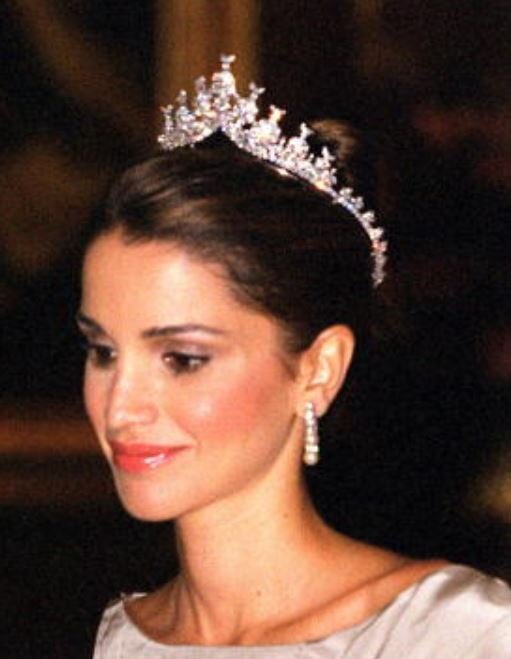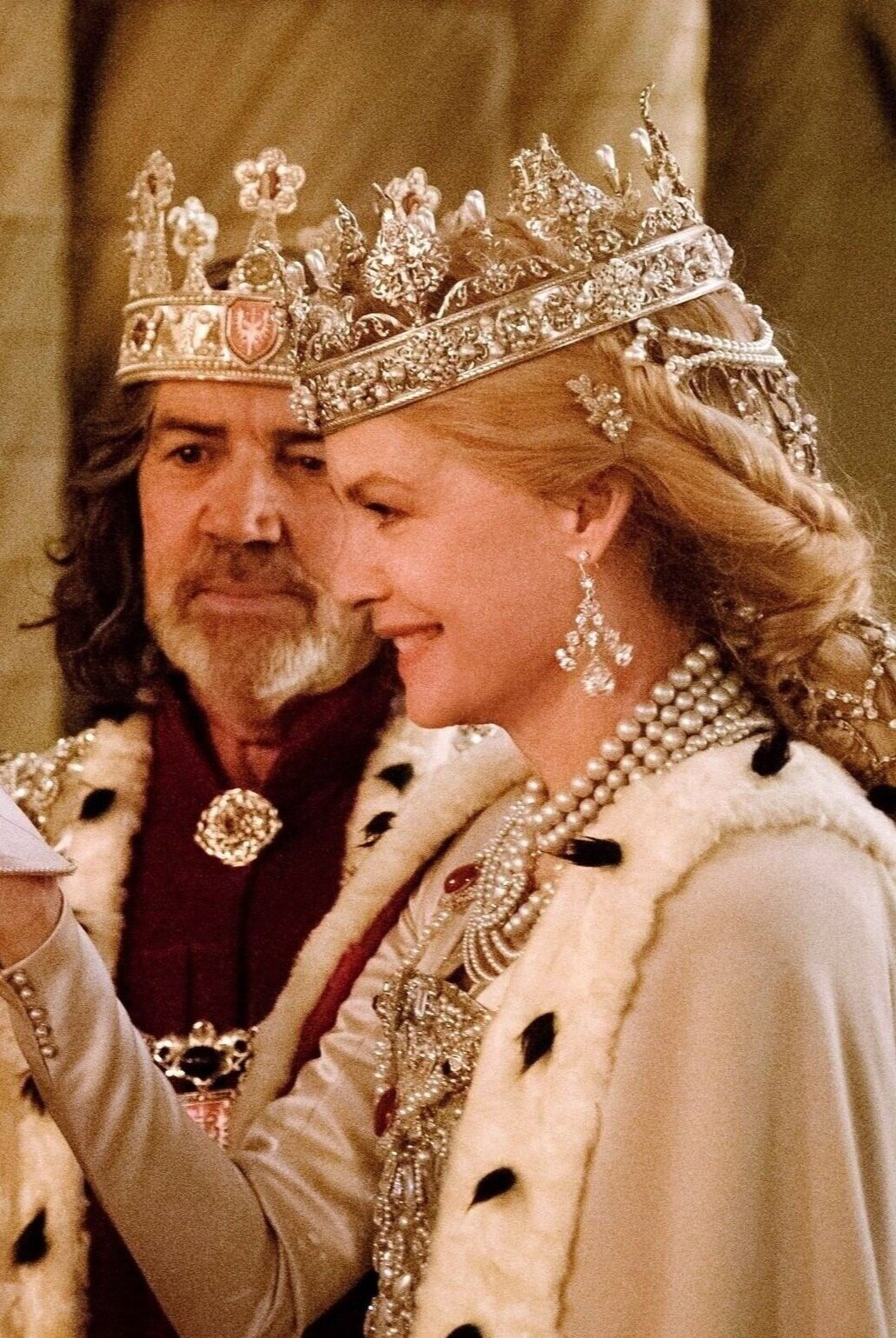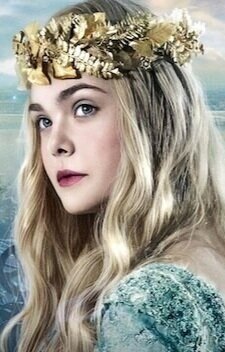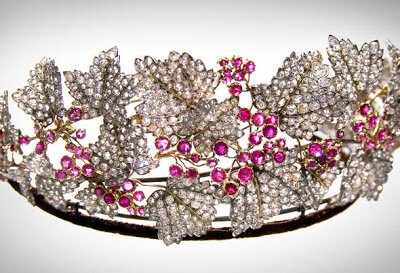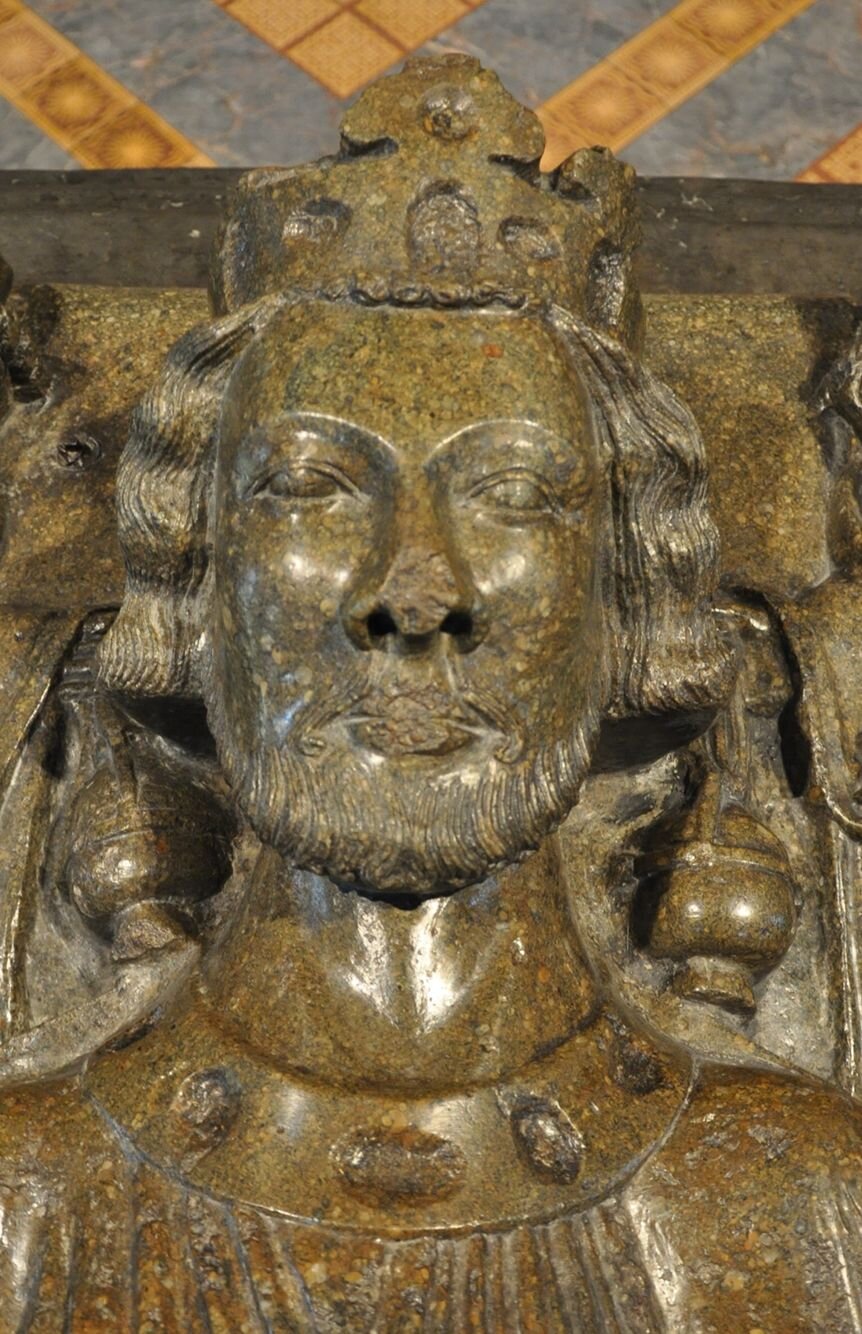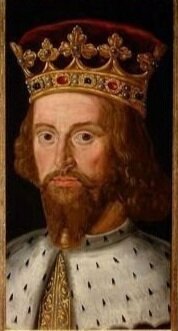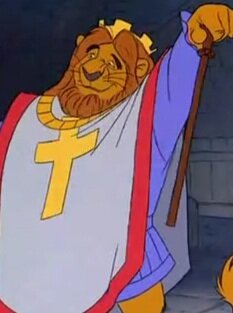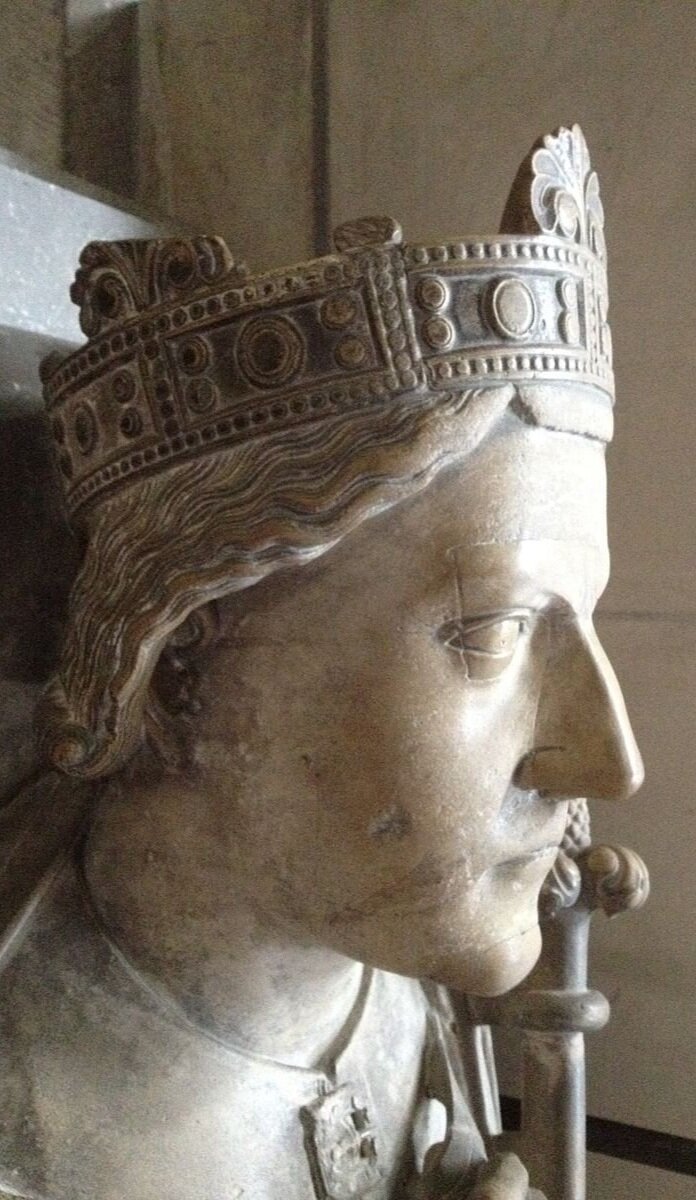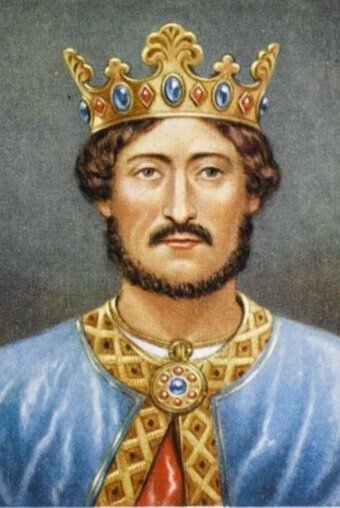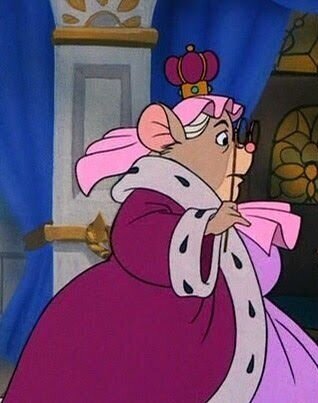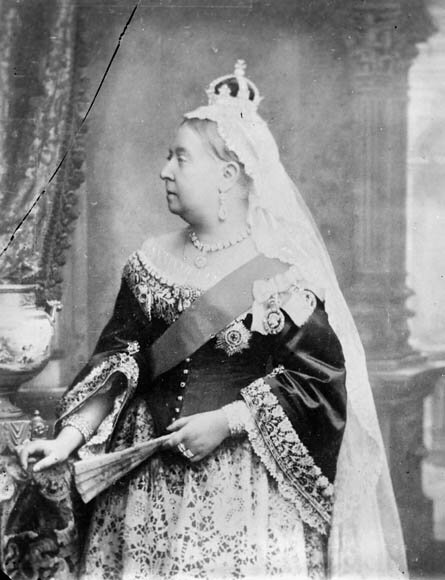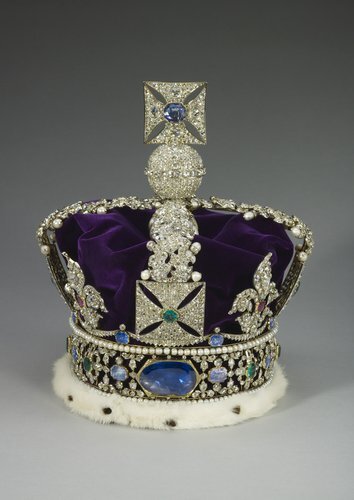Over-Analyzing The Crown: S4E3 Fairytale
All My Posts on The Crown
S3: 1 & 2: “Olding” & “Margaretology” 3: “Aberfan” 4: “Bubbikins, 5: “Coup” 6: “Tywysog Cymru” 7: “Moondust" 8: “Dangling Man” 9: “Imbroglio” 10: “Cri de Coeur”
S4: 1: “Gold Stick” 2: “The Balmoral Test” 3: “Fairytale” ( + Cinderella References) 4: “Favourites” 5: “Fagan” 6: “Terra Nullius” 7: ”The Hereditary Principle” 8: “48:1” 9: “Avalanche”
The Medals, Sashes, and Tiaras of The Crown; Tiaras/Crowns Overviews: Season 1 ; Season 2
Top: Charles and Diana in The Crown at their wedding rehearsal
Bottom: Real life Diana and Charles
Emma Corrin as Diana in The Crown, wearing a recreation of Diana’s wedding dress. The recreation of the dress took four weeks and 600 hours to create. The costume is made of 95 meters of fabric and 100 meters of lace, with a 30 meter train. Although they used different fabric to reduce creasing, the lace of the original wedding dress was recreated exactly. It’s pretty sad that we only saw it on screen for like, maybe a minute, because they did a brilliant job recreating it.
Since I had great fun over-analyzing every episode of Season 3 of The Crown last year, I’m doing the same thing this year! I’ll be /trying/ to write these posts up one episode at a time (although I may watch ahead a bit of my writing), so there won’t be spoilers for any main plot points of any episode except that which I’m covering in the post, although I may point out a little foreshadowing to later strife and such. So if you haven’t watched Season 4 Episode 3 of the Crown yet and don’t want to be spoiled, please stop reading now. :)
Content Warning: Eating Disorders. (I’ll include specific CWs on those portions of the post as well.
Upper left: Charles proposes to Diana on The Crown. Other three photos, Princess Diana in real life.
Content Warning: Eating Disorders [italicized]
This episode starts with a content warning about the scenes featuring bulimia nervosa. I’m glad they included this, as these trigger warnings are often very helpful for people in recovery trying to avoid relapse, however, there‘s unfortunately pretty good evidence that it doesn’t help as much as we might hope, particularly for people who are currently battling an eating disorder. This article talks about the issues with trigger warnings for eating disorders in-depth.
Content Warning end.Quick source note: I’ve been referencing Diana’s biography “Diana: Her True Story in her own words” by Andrew Morton a lot. This book is really the closest thing we have to a Diana autobiography, as she authorized it and gave hours of taped interviews for it. We really have to keep in mind though, that Diana’s interviews for it were conducted in the early 1990s, years after most of the events discussed had taken place, and was looking back at everything with the hindsight of knowing that her marriage hasn’t worked out very well. She also very much had an agenda with the book, as she wanted to get her side of the story out into the world so that if she began the process of separating from Charles, she wouldn’t look like the villain. In the original tapes, she never mentioned her own affairs or many of her own faults in the marriage. Although the author did do a lot of outside interviews and research and filled in the gaps around that, the book must ultimately be viewed through a lens of caution to this bias. After I finish that book, I do plan to go read the authorized Prince Charles biography by Jonathan Dimbleby, which was put together under similar circumstances and with similar motives, and come back and fill his viewpoint in a lot of these blogposts.
The episode starts with a montage of Diana leaving Windsor Castle and all the women in the royal family sitting by their phones, waiting for the news of Charles’s proposal to Diana.
We see: The Queen looking at a box of mementos, Princess Margaret getting her nails painted, Queen mother sitting on a couch, and Princess Anne wearing a colorful sweater and sitting on a couch between two large dogs. Their respective phones are all placed very prominently as we see each royal.
A mouse runs across the front of the scene featuring the Queen Mother and has become VERY NOTORIOUS ONLINE. The Crown’s official Twitter account even acknowledged it by tweeting “Outstanding Guest Actor in a Drama Series?” in response to someone’s screenshot pointing it out. There’s really no way to know whether the mouse’s cameo was intentional or not, as no one has spoken out about it, but I think it could be either. The relative neglect and decay of the palace has been mentioned before in Season 1 and 2, and it will come up again in a few episodes, when a visitor tells the Queen that the palace has a lot of peeling wall paint and such, so it really might have been a quite indication of that.
The exact location of the mouse is hard to pinpoint, as it’s not clear where each of the family members are at in this scene, though. Generally during their lives, the Queen Mother lived at Clarence House and Princess Margaret lived at Kensington Palace. Princess Anne lives at her own house in the Gloucestershire, which is further demonstrated in Episode 4. Throughout the year, the Queen lives mainly at Buckingham Palace, is usually at Windsor Castle from March-April and on the weekends, celebrated Christmas/New Year at Windsor for much of her life but now is usually at Sandringham for the winter holidays, and spends her summer holiday at Balmoral. This episode starts in 1981 at Windsor Castle; although there isn’t a month specified, in real life, they got engaged in February. So presumably the Queen was at Buckingham Palace when she got this call.Also Also, I personally like to think that this mouse cameo might be a reference to the Great Mouse Detective, which features a mouse queen who’s based off of Queen Victoria and lives in a palace that likely refers to Buckingham. You can find out more about the inspirations for the mouse queen’s look in one of my blog posts on the crowns and tiaras in Disney films.
As Diana drives away, Charles places a toy soldier in his hand by his phone. This seems like a reference to Lord Mountbatten. I feel like toy soldiers have appeared in The Crown before in Seasons 1-2 and I’m just not remembering the exact context. I’ll do a re-watch here soon and try to pinpoint the exact spot. I think there also was a brief moment with a toy soldier in Episode 1 of this season.
“It’s done. I did it.” - Charles to the Queen. What a romantic way of telling his mother he proposed. He did indeed propose to Diana in the nursery at Windsor Castle. He makes something of a big deal about not getting down on one knee to propose, as “i thought in terms of rank the prince of wales only knelt before the sovereign” (“it's a proposal of marriage dear, not a show of strength"), but in real life, he apparently did get down on one knee. She herself said that she nervously laughed at the request, thinking it was a joke at first, but said “yes.”
In the flash back to the proposal itself, Diana wears a red floral dress, and a bright blue cardigan with red, yellow, and blue detailing. Diana wore several red floral dresses in real life with distinctive collars like that. I couldn’t find any cardigan pictures quite like that, but Diana was very well known for wearing bright, often delightfully ridiculous sweaters, like a big koala sweater while she was pregnant.
In the biography “Diana: her true story in her own words,” based off of taped interviews with Diana, Diana said that she often said “yes, please” to Charles during their brief courtship, so her saying "yes please" in the show rings pretty true.
The entire phone conversation between the Queen, Queen Mother, Princess Margaret, and Princess Anne, makes it clear how relieved they are that he finally proposed but how generally appalled they are by how not romantic it was (“the nursery?”) and Charles’s tone deaf approach to the whole down on one knee question.
“Prostitutes and Australians. Isn’t that who lives in Earl’s Court?” Margaret is a delight. Also, apparently there was a pretty large population of Australians, New Zealanders, and South Africans living in Earl’s Court at the time. It began to be known as “Kangaroo Valley.” It also was known for having a thriving gay nightlife in the 1970s and 1980s; unfortunately, some of those clubs were known for prostitution, as Margaret astutely notes. The fact that Diana so happily lived in this area of London illustrates an early openness and love of all people. She would later become close friends with numerous gay celebrities, including Elton John and Freddie Mercury (who supposedly took her clubbing dressed in drag to keep her anonymous) and was famous for showing great compassion to AIDS victims and actually hugging them, in a time when people were often terrified of touching anyone with HIV.
Diana, on her drive back to her flat in London, listens to upside down by Diana Ross, which is all about love messing with your head.
I said upside down
You're turning me
You're giving love instinctively
Around and round you're turning meUpside down
Boy, you turn me
Inside out
And round and round
Diana immediately swarmed by reporters and photographers outside her flat as she leaves her car, many more than last episode. She just ignores all their questions. This is both accurate to real life and also sad foreshadowing to her own end. Diana was eventually given a few security officers to protect her, but not until after the engagement announcement and her move into the royal family’s homes. There were considerable complications before that as the press followed her and hounded her everywhere. She was so desperate to escape them that she would play tricks by switching cars with one of her flatmates, or her grandmother, and at least once she climbed out the window.
Top and bottom left photos: Diana on The Crown celebrating her engagement with her friends. Bottom right: Princess Diana (Credit: Tim Graham / Getty).
The entry hall to the Jungle Bar and Nightclub in London, which I’m 99% sure served as the location for the clubbing scene in S4e3. This club is the reimagined, one building over set up of Annabel’s club, where Diana held her hen do in real life.
Diana celebrates her engagement with her flatmates by dressing up, driving around town, and going dancing at a fabulous looking club that I’m nearly positive is The Jungle Bar and Nightclub in London. This club is actually a redesign of Annabel’s, an exclusive nightclub where Diana had her “hen do” (bachelorette party, for Americans), and is one building over from the original location.
Her biography by Andrew Norton said that Diana drove around town but didn’t talk about dancing. You can’t see her dress very well in the club scene but it’s sleeveless, with lots of ruffles, mid-calf length, and appears to be covered in light pastel flowers, mid-calf length. It looks very much like a ballgown she wore in later life.
This entire scene is set to the chorus of Stevie Nicks’ “Edge of Seventeen,” which actually came out on her album in July 1981 and as a single in 1982, so later than this scene is set place, but decently contemporary to the events. This is a really symbolic song inspired heavily by the death of Nicks’ uncle Jonathan and the death of John Lennon, which sounds really exciting and energetic and fun, but deals almost entirely with death. It’s yet another song foreshadowing Diana’s spiral and unfortunate end. Nicks has said that the “white winged dove” represents the spirit leaving the body on death. The “ooh baby ooh” section is meant to sound like a dove’s song.
Just like the white winged dove
Sings a song Sounds like she's singing
Ooh baby, ooh, said ooh [repeated]The scene ends with her friends uproariously singing “God Save the Queen,” but Diana said in her life that she had a premonition that she’d never become queen, even when Charles proposed.
Diana with her mother, Frances Shand-Kydd, both wearing their similar sapphire rings, at Wimbledon in 1993 (Credit: Daily Mail / Shutterstock).
The next scene shows “a rather special box of chocolates” of rings for Diana to choose from. She apparently did choose her ring from a selection of them. She initially looks at an oval ruby ring surrounded by small diamonds. The jeweler explains that it’s from the Mogok valley, the queen asks if she knows where that is, and Diana responds “oh i’m rather thick at geography.” The queen promptly says “Burma,” while Charles makes a face and chuckles, illustrating the divide between Charles and Diana which will only become more apparent as the episode and season goes on.
Burmese rubies are very popular and known for having a deep red color. They tend to be very rare and expensive. There really are several legends about the rubies in Burma, which the jeweller began to explain before he was interrupted by Diana choosing a different ring.
This ruby ring could be a reference to a few different things actually! The most famous burmese ruby in the English royal collection is the controversial Burmese Ruby tiara (much credit to the Court Jeweller for this post and everything I have ever learned about royal tiaras and jewels). Apparently this was made from the Nizam of Hyderabad Tiara, a diamond floral tiara that the queen received as wedding gift, from the Nizam, an Indian monarch who literally told Cartier to let the then-princess choose whatever she wanted from their collections as a wedding gift, much like in this scene with Diana. The tiara was dismantled in the 1970s and combined with another wedding gift, 96 rubies from the people of Burma, to make this tiara. People really liked the previous tiara and were upset at its being taken apart.
The ring itself in the show much more resembles a jewel from a different royal family, specifically, Queen Marie-Jose of Italy’s Ruby Ring, which is, in fact, made with a large Burmese ruby. It was offered for sale at auction recently with an estimated value of $5.8-$8.7 million.
The ruby ring also slightly resembles the ring that Prince Andres later gave his future wife, Sarah Ferguson (Fergie).Diana’s actual ring features an 18-carot oval-cut Sri Lankan sapphire. There is evidence that in real life, Diana did choose the sapphire ring because it reminded her of her mother’s ring and matched her eyes (her reasons given in The Crown) as well. It wasn’t custom made nor was it an heirloom ring, which made it unusual for royal ring (the queen’s ring was designed by Philip, Prince Andrew designed Fergie’s ruby ring, Charles proposed to Camilla with his grandmother’s diamond ring, and Prince Harry designed Meghan Markle’s diamond ring using diamonds that belonged to his mother). Prince William later used his mother’s ring to propose to Kate Middleton.
In this scene, Diana is wearing an outfit so similar to her engagement outfit that I initially thought it was the same one! The blue is almost exactly the same color. She’s sporting a pie crust collared shirt that’s very similar to those she wore in real life. She ended up really popularizing that collar style actually.
Upper left: Diana in The Crown looking at her new engagement ring. Upper Left: Princess Diana in a green dress.
Bottom: Princess Diana in various outfits
Left:Credit: Kypros / Getty; Right: Credit: Princess Diana Archive / Getty.
Left: Diana in The Crown, meeting the Royal Family after her engagement. Other photos: Diana in real life.
Next, the queen’s private secretary Martin Charteris passes on two suggestions from the Queen Mother: 1, that Diana be moved into Buckingham Palace before the engagement announcement to protect her from the media, and 2, that Diana be given some tutorials as to how to behave like a royal. Charteris suggests that the Queen teach Diana how to be a royal, but the Queen says she doesn’t have the time and that Lady Fermoy, Diana’s grandmother and the Queen Mother’s lady in waiting, can do so.
She was actually moved to Clarence House the day before the engagement was announced. She was later moved into Buckingham palace before the wedding.
I’ll talk about this more later on when we get to the actual “princess lessons,” but Diana said in interviews during her life that she was not given any training or education when she married Charles, although she really could have used it.
Note: Martin Charteris retired in 1977, so i’m slightly confused as to why they kept him as the queen’s secretary throughout all of season 3, which goes through 1990 - they must really like the actor!
We have a quick scene where Diana is hanging out with her flatmates for the last time before moving out and living with the royal family. As she walks down the stairs away from her flatmates, the camera actually spirals down with her. This is the first time this style of shot appears in this episode, but we’ll see it several more times, likely to illustrate her spiral down into her eating disorder. Diana going up and down stairs is also heavily featured throughout the stair, possibly referring to her change in status.
Note: Diana actually lived that flat in Earl’s Court, which her parents gave her when she was 18, after she had begged to be allowed to live in London for years.
In this scene, Diana says she’ll be on the phone with her friends day and night, which they laugh off, saying she’ll be too busy trying on tiaras and having tea brought to her. This illustrates that even her closest friends had a very “fairy tale” view of what Diana’s life would be like.
The scene where Diana meets all the family again in a more formal setting than Balmoral, forgets to curtsey to anyone, and then gets overwhelmed by all the rules and starts curtseying to the wrong people, is likely an exaggeration. The Spencer children grew up in a house on the Sandringham estate and regularly spent Christmases with the royal family while they were growing up. Both of Diana’s grandmothers served the Queen Mother (Lady Fermoy served the Queen Mother, as shown in the show, from 1956-1993, and her maternal Grandmother, Countess Spencer, served her from 1937-1972). They probably had royal protocol drilled into them by the time they were very young. Nerves could possibly excuse this though.
We know that Diana’s brother Charles DID make a similar error to this out of pure nerves at a post-wedding rehearsal party at the palace; he said he just bowed to everyone in sight and ended up accidentally bowing to a waiter (I read this in Diana: Her True Story in her Own Words).I couldn’t find a pastel plaid ball gown exactly like that shown in the awkward curtsey scene, but Diana certainly wore several similar outfits.
Left: The Crown. Right: real life (Credit: Reginal Davis / Shutterstock).
Left: The Crown. Right: real life (Credit: Anwar Hussein / Getty).
The Crown recreates Charles and Diana’s engagement announcement outfits almost perfectly. They also recreate the most famous segment of their engagement interview, in which a reporter asks if they’re in love, Diana says “of course,” and Charles says “whatever love is.” We have a video of the whole fiasco here, at about 7:40 in the video.
Diana’s family is never even shown in The Crown at all, except for Sarah in episode 1, but the engagement announcement does introduce her as “The Lady Diana Spencer, daughter of the Earl Spencer and the Honorable Mrs. Shand Kydd.” This is the only discussion we’ll ever see of the fact that Diana’s parents are divorced and had a very acrimonious separation, which involved Diana’s mother leaving her children and losing custody of them entirely. This tense childhood likely fueled her anxiety and mental health issues throughout her marriage and also contributed to her refusal to even consider divorcing Charles for a very long time.
I can’t find a screenshot from the Crown’s scene showing Diana saying good bye to Charles at the airport in the rain, but she wears a red velvet jacket with another piecrust collar shirt that’s tremendously similar to outfits she wore in real life. I did find a screenshot from another scene showing Diana in a outfit, with a green coat however, and have included that above side by side with photos of the real life Diana. Their conversation at the airport echoes their conversation after the opera in Episode 2, when Charles shrugs off the length of his trip away and Diana points out that their separation will be very long to her. This further illustrates that she’s much more attached to him than he was to her.
The Crown makes it look like the engagement was very short and that Charles was away on his trip almost the entire time, coming back only shortly before the wedding. In real life, Diana actually went on a trip to Australia immediately after Charles proposed in early February (he said later that he wanted to give her time to think about it if she didn’t want to say yes or no immediately), their engagement was announced in late February, and the two went to several public events together before their wedding happened in July 1981.
Charles tells Diana as they part that he’s asked Camilla to get in touch with her; Diana is already aware that Camilla is his ex, but doesn’t seem to realize how close they are yet. Charles seems to be trying here, but doesn’t seem to understand why Diana might not want to meet her or spend time with her, because after all “she's great fun...she's the best company.”
Left: Diana in The Crown, starting her princess lessons which absolutely did not happen in real life. Right: Diana in real life.
Bottom Right: Credit Julian Parker / Getty
Upper left: Diana in The Crown, watching news coverage about children making her congratulatory cards. Other photos: Diana in real life. Bottom Left: Credit Tim Graham / Getty
Honestly, the thing I despise most about this episode are these princess lesson scenes. These in no way happened. Diana spoke several times in real life about how she was thrown into the deep end of royal protocol and public appearances without any education or preparation. She also specifically noted that she was never given any training in public speaking. People have said that The Crown was deeply unfair to the royal family in this season, but honestly, I think they’re actually being a bit too nice in this sequence. The royals may not have realized how unfair this was to Diana at the time, as they were just a bit oblivious and likely thought her background as a noblewoman had already readied her for this sort of thing. Thankfully, the royals have really really worked to learn from their mistakes with Diana and gave considerable training AND additional security to both Kate Middleton (Prince William’s wife) and Meghan Markle (Prince Harry’s wife) before their weddings.
But yeah. These sequences where Diana’s grandmother trained her in royal protocol, public speaking, and the way that the royal household is run, are pure invention. They more resemble the plot of The Princess Diaries than real life. They’re most useful in showing how much Diana had to learn when she married Charles and how hard it all was on her, but the very fact that she DIDN’T get any of these lessons in real life only underlines how tough those early days were on her. I’m not going to get into royal protocol or expectations here, as there are a ton of them, but this article from Harper’s Bazaar talks about a lot of them (I should also note that things have definitely loosened up since the Queen Mother’s death and a lot of these rules aren’t really enforced anymore).This sequence also does seem to indicate Diana’s rough relationship with Lady Fermoy. As I’ve noted previously, in real life, Lady Fermoy actually mildly advised against Diana marrying Charles, as she didn’t think the royal life would suit her. We don’t know the full details of what happened between them, but apparently Diana was not on speaking terms with her grandmother when Lady Fermoy died in 1993.
The plaid outfit Diana’s wearing in some of these scenes is very similar to ones she wore in real life.
This episode features a lot of quick shots of Diana looking at portraits around the Palace in awe, probably imagining her new life. In this scene, she’s looking at Queen Victoria’s coronation portrait. Victoria became queen when she was only 18 and married when she was 20/21, about Diana’s age at the time of her marriage (although I should note that Victoria’s husband was about her same age and they seemed to overall have a very happy marriage).
We have a lot of Diana Montage scenes coming up next, which I’ll run through quickly:
A lot of these scenes and in between moments really emphasize how alone Diana feels in her apartments at the palace, a stark contrast to the happy jollity shown in the scenes at her flat in Earl’s Court.
The next morning, Diana wakes up to Vienna by Ultravox playing as her alarm clock, which is a song written about a holiday romance with a dark tone. It’s only a very brief snippet, but the lyrics we hear are: “The music is weaving. …The image has gone, only you and I. It means nothing to me.”
Diana (once again shown with a portrait of young Queen Victoria, this time, wearing her wedding dress) appears in a white pie crust collar shirt with black ribbon tie to receive and start reading through all her post. She’s shown writing a letter to at least one person. In real life, Diana apparently did write lots of letters.
The dance lesson sequence kind of makes it look like Diana isn’t enjoying herself and is forced into it, as she has sort of a forced smile on her face, but in fact, she specially requested that the dance teacher and piano player come to the palace for lessons, as ballet helped her deal with stress. I couldn’t find any real life photos of Diana in dance costume that seemed legitimate (there are a few photos floating around claiming to be Diana as a teenager in a leotard doing ballet, but I couldn’t find a reliable source and her hair was dark brown rather than light brown, so I elected not to share those here, as I somewhat suspect they’re actually of one of her sisters). However, she did do ballet in school and really loved it, sneaking out of her dorm at night to go dance as stress relief. She also taught ballet for a while until a ski accident put her out of commission for several months. I did find some photos of her working out in a leotard and with several dance groups though.
Diana watching television alone as the news reports about elementary school children sending her wedding cards. She’s wearing her notorious “black sheep sweater,” which real life Diana wore several times in public over the years.
Diana listens to Girls on Film by DuranDuran on a tape deck as she skates around the palace. Diana definitely roller bladed in her life, but I’m unsure whether she would have roller skated inside a palace. Apparently there is evidence that she rode her bicycle around the palace though, so - maybe! She skates past the throne room and ends up stopping and looking at yet another painting of Queen Victoria (I figured it out it was this one) as grand soundtrack chords overpower Duran Duran, indicating her thoughts.
This Duran Duran song really speaks to the situation, as it was inspired by the dark side of glitz and glamor. The song’s music video was actually quite controversial as the time, as they made it with lots of nudity with the idea that it would just be played in nightclubs, but then it showed up on MTV (with the nudes removed) and pissed everyone off.This continues the trend of often using vaguely foreboding songs when Diana is around.
The actual lyrics in the show are:
And I sense a rhythm humming in a frenzy
All the way down her spineGirls on film [repeat several times]
Another scene of Diana sitting alone in her apartments looking anxious, looking out the window.
Diana meeting and learning all the staff titles with her grandmother, wearing a light blue floral vest and matching skirt with a white shirt.
Diana watching more footage of her wedding and trying to contact Prince Charles’s private secretary, then the Queen, and unable to reach anyone. The congratulatory flowers in her apartment are starting to multiply and become really apparent in this scene.
Content Warning: Eating Disorders [italicized]
Another spiral staircase scene, as Diana runs down the stairs in her pajamas and a pale yellow robe to the kitchen, where she stress eats several desserts and then throws them up later. This is the first sign we’ve seen of her bulimia in the show. Diana claimed that her bulimia was sparked by Charles putting his hands on her waist during their engagement and saying something along the lines of “oh, a bit chubby here, aren’t we?”
Content Warning End.
Left: Emma Corrin as Diana in The Crown. Middle: Diana with Prince Harry as a child. Right: Diana roller roller blading.
Middle credit Time Graham / Getty.
Upper left: Emma Corrin as Diana in The Crown. Upper right: Diana working out in real life. Bottom pictures: Diana meeting various dancers. Bottom right credit Princess Diana Archive / Getty.
Diana, bored in her apartments, starts to watch a children’s cartoon, Bagpuss, barely looking up as multiple carts of post (mail) are brought into her apartment, along with more flowers. The bouquets continue to multiply in her apartment rather ominously.
Bagpuss was a children’s show that aired only 13 episodes in the 1970s. This scene again underlines Diana’s young age and despair.
Diana calls a friend and walks around her apartment, where flowers now appear all around, on every surface and in every frame. She tells her friend that she hasn’t heard from Charles in three weeks. “I get letters from people all over the world but nothing, not a squeak, from the man I'm supposed to marry.” In real life, Diana said that she received a bouquet of flowers from Charles, but the lack of a note on it indicated to her pretty clearly that it was sent by Charles’s staff, not him personally. She finds a note from Camilla Parker Bowles and hangs up on her friends abruptly, without a goodbye. We get magnificent screechy horror strings music in the background as well.
Left: Emma Corrin as Diana in The Crown. Other Photos: Diana in real life.
Top: The Crown; Bottom: Real Life.
She goes to lunch with Camilla at a place literally called Ménage à trois, which is a bit on the nose, huh? (a Ménage à trois is an arrangement in which three people have a sexual relationship). My husband pointed out that the restaurant has a French name but that the waiter speaks to them in Italian, which is weird. This was ACTUALLY a real restaurant that opened in London which only served starters and puddings, just like the one in the show.
Diana is dressed in a skirt suit in a pale yellow color, which contrasts a very feminine, young color with a more grown up silhouette. Camilla is in a very grown up looking black suit. These clothes resemble outfits their real life counterparts wore, but their juxtaposition highlights their age difference. Diana is barely 20 at this point in the story, while Camilla is 33 (actually a year older than Charles).
Apparently to heighten the tension and awkwardness of this scene, the director brought in the actor who plays Charles and had him sit between the women as they rehearsed their scene. He told the women, “only one of you can put your hand on his,” and Emerald Fennell (who plays Camilla) immediately put her hand on Josh O’Connor’s and kept it there the whole time. This ended up really making the actors feel Charles’s presence, even though he’s not there in the final scene.
I have a small theory that this season, with Diana and Charles, blue and yellow are important colors (these are both represented in the Prince of Wales’ seal, which is on a ring that Charles gives to Diana later in this episode). Once they’re a couple, they both wear blue when they are in harmony and their marriage is going well; Diana’s dissatisfaction with her relationship is represented by her wearing yellow. This trend won’t really become apparent until later in the season, but I think it’s noticeable that she’s wearing yellow in this particular scene, when she begins to realize how little she knows Charles and how very very close he and Camilla are. She also was wearing a yellow robe in the scene where she begins to binge and purge.
I think I’ve mentioned this before, but both Camilla and her husband were at Balmoral on the first weekend Diana spent there, so she had already met them in real life.
Conversation highlights indicating how very odd and specific Charles is:
"He's so fussy and set in his ways. He'll love it if you adapt to him."
Camilla reveals that Charles doesn’t eat lunch, as it’s supposed to be good for his health to only have two meals a day. This is true, and also finally explains Anne’s thrown off comment that “he doesn’t eat lunch anymore” in S4E1. It’s also rumored that Charles really does eat a soft boiled egg with everything.
"You know how he surrounds himself with old men and daddy substitutes." As was revealed in Season 2 and S4E1, Charles does NOT have a good relationship with his father Philip, and latched on to Lord Mountbatten as an elder “daddy substitute” figure. This is pretty accurate to real life as well.
Charles and Camilla really did call each other Gladys and Fred, names drawn from The Goon Show. Camilla didn’t tell this to Diana though; Diana figured it out from Charles’ friends and various notes he left behind.
When they banter about who should take the check and Camilla finally agrees to go Dutch, she says “I’m all for sharing, “ which again, is a bit on the nose, y’all.
Immediately after the lunch with Camilla, Diana retches in her apartments at the palace.
The incident where Diana found drawings of a bracelet with “Fred and Gladys” and “GF” on them on Charles’s secretary’s desk is pretty close to what happened in real life (Note: Diana is wearing yellow again in this scene!). In real life, Diana found the actual bracelet, with the initials “GF” on it. Just as the secretary in the show won’t answer who the bracelet is for, one of Charles’s servants wouldn’t answer Diana’s questions about it in real life.
Right after this scene, we get another spiral scene, of Diana running up the stairs to her apartment, where she is completely SURROUNDED BY FLOWERS, and after being told the Queen is unavailable, has a bit of a breakdown, pushing things off a table and putting her face in her hands in frustration.
In real life, Diana also determined before the wedding that she really should call it off. She told her sisters this, but they joked that her face was already on the tea towels, so she was stuck.
In the next scene, Diana dances first sedately and then more energetically and improvisationally to Elton John’s “Song for Guy,” which is a mainly instrumental song released in 1978. Elton John said later that he wrote this song while thinking about death; he was told the next day that Guy Burchett, his 17-year-old messenger boy, had been tragically killed on his motorcycle the day before. It’s one of the only few songs written by Elton John alone and only includes a few words at the end, which are simply “Life isn’t everything” repeated over and over again. Again, lots of foreboding music used when Diana is around. By the end of the scene, the music is drowned out by more somber instrumental music and Diana collapses on the floor.
Diana said in “Diana: Her True Story in her Own Words” that she often danced in the large hall at her family’s home in Althorpe, surrounded by large paintings. This scene seems to echo that.
Actress Emma Corrin asked if she could make up her own dance in this scene to Cher’s “Believe” (rather than choreographing anything in particular) and the director agreed to allow her to do it. Of course, that song isn’t period appropriate, so they changed it out in post-production, but the song definitely seems to help the actress’s sense of fun and energy come out. Corrin has also said that she’s a terrible dancer, so she was pretty nervous when she found out how large a role dancing played in Diana’s life.
Diana was close friends with Elton John in real life. He re-wrote and recorded “Candle in the Wind” in her honor after her death in 1997, which became a hit and raised lots of money for her charities.
Charles gets back into the country and we see him going to see Camilla first thing. We only see the aftermath of their meeting the next morning, as she's smoking a cigarette.
“I vow to thee my coutnry,” a patriotic hymn set to “Thaxted” by Gustav Holst (also known as the hymn melody from Holst’s “The Planets”), which plays in the background as Charles arrives at his wedding rehearsal, was actually sung at their wedding. Diana requested the song especially, saying that it had always been a favorite of hers. It was also sung at her funeral.
Top: Various views of Princess Margaret in The Crown in episode 3.
Bottom: Various views of Princess Margaret in real life wearing similar silhouettes and colors. Credit L to R: Central Press / Getty, PA / Getty, Tim Graham / Getty
Top: Anne, Margaret, and the Queen Mother in The Crown.
Bottom: The royal family at Charles and Diana’s wedding, with Anne, Margaret, and the Queen Mother all visible in a row at the left (Credit: Bettmann / Getty).
As Charles arrives at their wedding rehearsal at St. Paul’s Cathedral (with lots of crowds cheering outside), Diana sits in the corner quietly freaking out. When he arrives, she stands and quietly but angrily confronts him - asking why he went straight to Gloucestershire and saying that she found the bracelet and knows about “Gladys.” Princess Margaret looks at them with a worried face.
They’re wearing basically exactly what they wore in real life.
Charles claims that the bracelet was made as a farewell gift, a souvenir, and also states that he went to Gloucestershire to tell Camilla face to face that it’s over, and also to pick up a signet ring for Diana.
All the scenes with Charles and Diana in St. Paul’s are shot with the cathedral just towering all around them, illustrating how small they really are in the grand scheme of things in the royal family.
In the rehearsal itself, the traditional wedding service is read out, pointing out that marriage should not be entered into unadvisedly. or lightly. Princess Margaret in the background grows increasingly concerned looking, clearly thinking about her own marriage and divorce.
That night, Prince Philip arrive at the palace and asks how the rehearsal went. The Queen notes that she and the Queen Mother that that it was lovely, but Margaret disagrees. Margaret than logically points out that Charles is in love with somebody else and asks, “How many times can this family make the same mistake. Forbidding marriages that should be allowed. forcing others that shouldn't. Paying the consequences each time.” Philip responds: “He's marrying Diana." Margaret: “But he's still in love with the other one.”
Margaret’s words, of course, refer to several situations: Edward VIII abdicating the throne so that he can marry divorcee Wallis Simpson, Margaret herself being forced to choose between her lover Peter Townsend and her royal status, Charles being unable to marry Camilla, and the current situation of Charles being forced to marry Diana, who he barely knows.
The argument continues: Philip argues, "The older Diana gets, the more confident Diana becomes, the more beautiful Diana becomes, and she will - the more Charles will fall in love with her - and this will all be fine." Margaret, “in the meantime he juggles them both?" Queen Mother: "That's how it works. That's how it’s always worked." Margaret, the only one talking reason: "That's madness - we have to stop them now - not just for the sake of the monarchy but for them as human beings.”
We have no evidence that any of these conversations happened before the wedding. It does seem that both Diana and Charles wanted to call off the wedding beforehand, but it’s unclear whether they brought these concerns to anyone in the royal family itself.
As celebratory fireworks go off ominously in the background, sounding honestly more like gun shots, the Queen goes to talk to Charles, who is gazing out a window alone and looking extremely miserable. His face looks terribly gaunt and his eyes are all sunken.
To encourage Charles, the Queen tells him the story of Mary, who was meant to marry her prince charming, but alas, after he died, ended up having to marry his younger brother, “prince charmless,” noting that there was no attraction between the two of them and certainly no love. But the two focused on their duty to their country, and “worked and worked and worked, and out of that work a tiny seed grew, a seed of respect and admiration, a seed that grew into a flower they could eventually call love.” She ends the story by noting that they were married for 42 years, stabilized a country “that was at war with itself”, while all around them great monarchies fell (here, she likely is referring to World War I, which featured many British royals and descendants of British royals on both sides of the war).
Reminder: we saw Mary in the first season of The Crown, as she was the mother of Elizabeth’s father.
I don’t know how accurate this story is, honestly. Vanity Fair did a recent roundup of awkward royal engagements that portrayed the relationship between Mary and her two princes very differently, indicating that her original fiance Eddy was actually much more awkward and odd and that Mary preferred his younger brother George from the start. By all accounts though, they did have a long happy marriage, her husband never took a mistress (although his father had had MANY), and they constantly wrote to each other while apart.
“I cannot claim to be the most intuitive mother, but i do know when one of my children is unhappy. Whatever wretchedness you feel now, whatever doubts you feel now, if you could follow the example of your great grandmother, love and happiness will surely follow." - The Queen to Charles.
I feel like this sort of advice was predicated on the idea that both Charles and Diana would be mature, responsible, and respectful to themselves, their duties, and each other, and honestly, neither of them really did a very good job with that.
On the morning of the wedding, Diana is no longer surrounded by flowers at least. She looks at her engagement and signet rings carefully and fingers them thoughtfully, like Charles did with his toy soldier at the beginning of the episode. A radio broadcast plays in the background discussing the weather for the day.
Note: The Emmanuels, who designed Diana’s wedding dress, actually made a little umbrella to go with it, but the dress’s material would have done Very Badly in the rain and had a gigantic skirt and train that wouldn’t have fit under the umbrella, so honestly, they’re really lucky it didn’t rain. We also see sevearl shots of the huge crowds outside the palace and along the wedding parade route.
As the episode draws to a close, we see all the royal women we saw at the beginning of the episode waiting for a phone call with engagement news now getting ready for the wedding. Anne and Margaret look miserable, although the Queen Margaret and the Queen look fairly happy. They’re all dressed in outfits extremely similar to what they wore in real life.
I wonder at the focus on the royal women. The montage does move on to show Philip, Charles, and Diana all getting ready for the wedding, but the fact that the episode starts and ends with a focus on four royal women is…very interesting. Is it meant to show something about all the relationship sacrifices they made for the monarchy? From all reports the Queen Mother’s marriage was happy, and although Elizabeth and Philip had some issues, they’ve been pretty good, but Anne and Margaret’s marriages both ended in divorce (Anne has remarried since and seems much happier), so they two in particular seem to really realize the situation that Charles and Diana are getting into.
Philip looks at his wife after they’re both ready for the wedding, smiles, and then walks away away. They have a friendship and a sweetness to them that I appreciate, but I miss the passion they showed in earlier seasons. The show doesn’t even bother to portray them as romantic beings for the vast majority of this season, which I dislike. There’s like one moment in the fourth episode where the Queen leaves her door open and Philip asks if it was a signal for him to come in, and the Queen instantly shoots him down and says she just wants to talk, which…./sigh/
Upper left, the design of Diana’s dress by the Emmanuels (Credit: Central Press / Getty). Lower left, the dress in The Crown. Right: Charles and Diana on their actual wedding day (Credit: Mirrorpix / Getty).
Left: Charles in The Crown. Right: Charles in real life (Credit: Express Newspapers / Getty).
The episode ends with the words of the archbishop on their wedding day, over shots of Diana and Charles getting ready. The words of the service would be so very on point if the couple was actually right for each other and loved each other and were willing to wok together, but as it is, it just underlines the sadness of the actual story.
“Here is the stuff of which fairy tales are made. A prince and princess on their wedding day. But fairytales usually end at this point with the simple phrase, ‘They lived happily ever after.' As husband and wife live out their vows, loving and cherishing one another, sharing life’s splendors and miseries, achievements and setbacks, they will be transformed in the process. Our faith sees the wedding day not as the place of arrival, but the place where the adventure really begins.”
The IMDB page for this episode doesn’t list any credits for the archbishop, so I believe this last bit was actually taken from the actual audio of their wedding.
The creators of the show have said a few times that they didn’t feel the need to show the wedding itself, as it was an extremely documented event at the time. You can actually watch the whole ceremony online and look through their wedding program as well.

